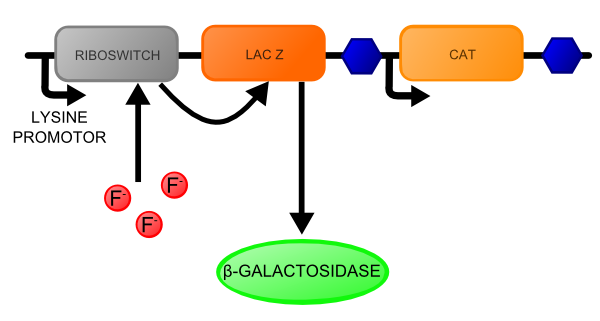Team:Cambridge/Project/FluorideRiboswitch
From 2012.igem.org
| Line 6: | Line 6: | ||
We have kindly been provided with a plasmid from the [[Team:Cambridge/Special_thanks|Breaker lab]] in Yale University, the key features of which are shown below: | We have kindly been provided with a plasmid from the [[Team:Cambridge/Special_thanks|Breaker lab]] in Yale University, the key features of which are shown below: | ||
| + | |||
| + | [[File: OriginalFRSConstructpng.png|750px|center|thumb|The riboswitch construct we received.]] | ||
| + | |||
| + | Our aim was to characterise it in this construct, before switching out the riboswitch into the construct seen below. However, due to time limitations, this was not possible. | ||
[[File: F-riboswitch.png|750px|center|thumb|Our riboswitch construct for the detection of fluoride.]] | [[File: F-riboswitch.png|750px|center|thumb|Our riboswitch construct for the detection of fluoride.]] | ||
| - | For the results of our characterisation assays, please see our [[Team:Cambridge/Project/Results|<span style="color:#000066"><u>Results page</u></span>]] | + | For the results of our characterisation assays, please see our [[Team:Cambridge/Project/Results|<span style="color:#000066"><u>Results page</u></span>]]. |
===References=== | ===References=== | ||
Revision as of 02:19, 27 September 2012


Fluoride riboswitch
We also plan on implementing and characterising a Fluoride riboswitch. This, unlike the Magnesium construct, is a positive regulator. The riboswitch, originally isolated from Bacillus cereus, serves as a transcriptional attenuator in the absence of fluoride. In the presence of fluoride its conformation changes and the repression is lifted. In B. cereus this serves to permit translation of a fluoride efflux pump, which allows the bacteria to cope with the potentially toxic fluoride levels in which it finds itself.
We have kindly been provided with a plasmid from the Breaker lab in Yale University, the key features of which are shown below:
Our aim was to characterise it in this construct, before switching out the riboswitch into the construct seen below. However, due to time limitations, this was not possible.
For the results of our characterisation assays, please see our Results page.
References
- Jenny L. Baker et al., Widespread Genetic Switches and Toxicity Resistance Proteins for Fluoride, Science 335, 233-235.
 "
"

